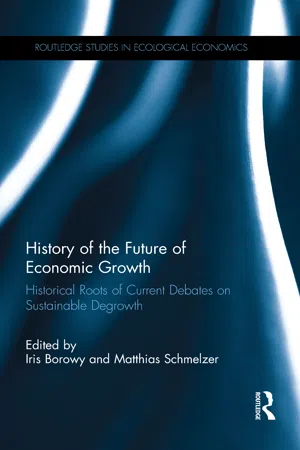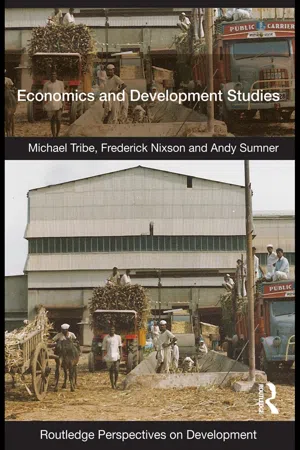Economic Growth
Economic growth refers to the increase in a country's production of goods and services over time. It is often measured by the rise in a nation's gross domestic product (GDP) and is a key indicator of a country's overall economic health. Sustainable economic growth is essential for improving living standards and reducing poverty.
8 Key excerpts on "Economic Growth"
- eBook - ePub
- Stanley Bober(Author)
- 2016(Publication Date)
- Routledge(Publisher)
...7 Growth Economics and Distribution Introduction What do we mean by that often spoken, popular term Economic Growth? As a working definition, we could say that the subject of growth deals with how a society achieves increasing levels of real aggregate output over long periods of time. It is an understanding of how an economic system translates the expansion of its potential real GDP into actual increases in real output. The reader will recall the use of the production-possibilities curve as a way to demonstrate the need to make economic choices—the “what is to be produced” question—where the position of the curve at a point in time reflects a given level of production capability. Soon after, the discussion involves an awareness that at a later time period the curve will have shifted outwardly, so that any choice point on the outer curve reveals greater output levels than any point on the inner curve. And this is because over time the society will find an increase in its ability to produce due to a greater level of economic resources coupled with ongoing technological progress. Implicit in all this is that as the possibilities curve moves outwardly, telling us of the increasing potentiality of production, the actual choice point will always be found on the outmost curve. Also, that the long-run view of economic performance is one of growth, and we mean a circumstance where the ongoing evolution of the society’s capability of production is mirrored in its actual secular growth rate of output. We would, perhaps, all agree with Samuelson and Nordhaus’s assessment that “Economic Growth is the simple most important factor in the economic success of nations in the long-run.” 1 The subject of Economic Growth is of primary importance for some obvious reasons. It is clear that if the population is growing, real income must also grow. A lack of growth in real output will simply translate into a reduction in living standards, which itself may negatively affect population growth...
- eBook - ePub
Contemporary Economics
An Applications Approach
- Robert Carbaugh(Author)
- 2016(Publication Date)
- Routledge(Publisher)
...Which measure of GDP is superior for assessing the performance of the economy, especially rates of Economic Growth? Long-Run Economic Growth In the past 25 years, we have seen the development of many new products, such as personal computers, cell phones, and fax machines. Indeed, new products are a reflection of our economic progress. Over time, we produce not only more goods and services but also new and better goods and services. As a result, our material standard of living increases. A nation realizes Economic Growth when it increases its full production level of output over time. Recall from Chapter 1 that Economic Growth can be expressed in terms of the production possibilities model. When Economic Growth occurs, a nation’s production possibilities curve shifts outward, or to the right. Economic Growth is a long-run objective that can be achieved over a period of time. Although Economic Growth suggests an increase in full production output over time, a more accurately definition is a rise in full production output per person over time. Suppose that output rises by 10 percent over time, but population grows at 12 percent over the same period. As a result, output per person would decrease. Even with more goods and services available, the average person would be worse off. The Rate of Economic Growth Let us now calculate the rate of growth in an economy. The rate of Economic Growth is the percentage change in the level of economic activity from one year to the next. Typically, analysts look at the rate of growth in an economy’s real GDP. The rate of Economic Growth is simply the change in real GDP between two periods divided by real GDP in the first period. To illustrate, suppose that in year 1 real GDP is $1,000 and in year 2 real GDP is $1,100...
- eBook - ePub
- Anthony J. Makin(Author)
- 2016(Publication Date)
- Routledge(Publisher)
...C H A P T E R 14 Economic Growth An economy’s growth rate determines its standard of living on an income per head basis. Around the world, living standards differ markedly. For instance, average household income in many advanced economies is at least ten times higher than in many developing economies. Meanwhile, economies in East Asia, including China, Japan, Singapore and South Korea, have experienced rates of growth unsurpassed in human history that have lifted hundreds of millions of people out of poverty over the past half century. This chapter focuses on the key factors influencing trends in GDP growth, around which an economy’s business cycle fluctuates. At the most fundamental level, well-defined property rights and a well-functioning legal system that foster market exchange are essential for sustained Economic Growth. Meanwhile, excessive regulation that restricts economic production and exchange stymies Economic Growth by limiting market exchange. Conventional growth theory explains long-term economic performance with reference to the factor inputs to production – the domestic labour force, the capital stock and technological improvement. Before analysing the relationship between factor inputs and Economic Growth in depth, let us first consider some historical features of Economic Growth in advanced economies. Economic Growth and living standards The composition of domestic production in advanced economies changed substantially over recent centuries. The relative share of agriculture in GDP shrank dramatically, while manufacturing industry waxed then waned, and services grew to account for well over half of GDP. From the beginning of the previous century, the agricultural sector in Australia, the United States, United Kingdom, Japan and other advanced Eurpoean economies ceased to be a major source of employment...
- eBook - ePub
History of the Future of Economic Growth
Historical Roots of Current Debates on Sustainable Degrowth
- Iris Borowy, Matthias Schmelzer, Iris Borowy, Matthias Schmelzer(Authors)
- 2017(Publication Date)
- Routledge(Publisher)
...Using per capita GNP/GDP allows comparing the economies of countries of different population sizes. While this definition has always stayed at the core of what is meant by Economic Growth, the concept has become charged with a multitude of contested and shifting meanings, assumptions, and connotations. Often, Economic Growth is equated with development (in itself a contested concept), social progress, economic improvement, or the expansion of material through-put. This diversity of meaning is hardly surprising since, as the various contributions to this book make clear, the concept of economic quantification – or even of a recognizable “economy” – has been contingent on circumstances, is highly contested among various social groups, has evolved over time, and is likely to continue to do so in the future (for more details, see Fioramonti 2013; Speich-Chassé 2013; Schmelzer 2016). For a long time, Economic Growth drew its legitimacy from its promise of providing the means both for improvements of individual living conditions and for social progress. This may explain why the idea of continuing Economic Growth has been broadly endorsed, readily taken for granted, and rarely questioned. The concept proved attractive both in those high-income countries, which had experienced substantial Economic Growth already, and in low-income countries, where people were hoping to get their share of the benefits of increased income in the future. However, the advantages of Economic Growth have always come at a social and/or environmental price, giving rise to concerns, which have repeatedly been articulated on the fringes of academia and society. As prospects for future growth seem bleaker than they have been in the past, discussions about the future of Economic Growth have gained strength and are beginning to spread into the mainstream of public discussions...
- eBook - ePub
- Gerard Roland(Author)
- 2016(Publication Date)
- Routledge(Publisher)
...Underscoring the power of these two emerging economies, India and China together include more than one-third of the world population. It is important to distinguish between economic development and Economic Growth. Economic development refers to improvements in living standards and in the quality of life, while Economic Growth measures only growth in economic production. Economic Growth may not accurately reflect all aspects of economic development because growth often results in negative effects on the quality of life such as pollution and urban congestion. Nevertheless, economic development cannot take place without Economic Growth. Growth is thus fundamental to development. I n this chapter, we introduce some important economic concepts to consider when discussing Economic Growth. We then review two very important theories of Economic Growth that explain the capital accumulation process. We will show that these theories, and others, based on capital accumulation explain only a small part of the differences in growth among countries. We then discuss the empirical evidence for the main causes of growth and highlight two important explanations for why some countries are so wealthy and others are so poor: geography and institutions. Currently, economists believe that institutions are central to understanding economic performance and Economic Growth in developing countries. The impact of institutions on growth will continue to inform our discussion of institutions throughout the remainder of the book. Growth and Factors of Production When we analyze the sources of Economic Growth, the first thing we must consider is the contribution made by the factors of production. Factors of Production Consider the output of a firm producing T-shirts. The firm generates output by combining labor and capital (machines, buildings, trucks). Labor and capital are critical factors in the creation of value and in the production of output in an economy...
- Eckhard Siggel(Author)
- 2016(Publication Date)
- Routledge(Publisher)
...The formation of institutions, both private and public, and their governance is a distinguishing feature of economic development. While most traditional approaches in economics are limited to analysing non-institutional factors, attention has recently shifted towards analyzes of institutional growth covering private firms, government, as well as norms and networks of the civil society. This new emphasis in development economics is clearly visible in the fact that two recent World Development Reports of the World Bank (2002 and 2003) are dedicated to building and transforming institutions. The latter Report also contributes to a widening of the concept of economic development by adding the dimension of sustainability. 1.2 Measurement of Economic Growth Economic Growth is an increase in real income or production (GDP or GNP) of an economy. In order to result in an increase in living standards, Economic Growth has to occur in terms of per capita income. In other words, income has to grow faster than the population. When measuring per capita income and its growth, we must first remember the differences between national income, gross national product (GNP), and gross domestic product (GDP), although they do not matter for the present purpose. While GDP is the total value of all economic activities that take place within the geographical frontiers of a country, GNP is the value of production of all factors that are owned by the Nation’s citizens. Taking the letter Y for either of these income concepts, N for the size of population, and y = Y/N for per capita income, g y = Δ(Y/N)/(Y/N) is the proportional growth rate of per capita income. Whenever we observe growth over a period of several years, we can express the average annual growth rate in two different ways, the continuous and the discrete growth rate...
- eBook - ePub
Economics After the Crisis
An Introduction to Economics from a Pluralist and Global Perspective
- Irene van Staveren(Author)
- 2014(Publication Date)
- Routledge(Publisher)
...If social policy improves the position of a disadvantaged group, Economic Growth provides the possibility to finance this from an expansion of output. This reduces potential conflict as compared to the situation of redistribution from a fixed amount of output away from other groups. Moreover, individuals and families like to see progress in their economic position over time as a reward for their investment in schooling, work experience, and increased labour productivity. If they do not manage to improve their relative position vis-à-vis others, Economic Growth can at least provide them with progress in their own position over time. 12.1.1.3 Poverty The third justification for the widespread concern among economists and policy makers with Economic Growth is the fact that many people in the world live in poverty – about 1 billion people. An increase in GDP and particularly in GDP per capita (so, higher GDP growth than population growth) provides the resources for more jobs and income for the poor and more public good provisioning in social sectors by the state. Obviously, poverty reduction also depends on how growth is distributed over the population. Several countries, such as Pakistan and Ethiopia, have seen good growth rates over a decade or more, but slow improvements in poverty reduction and human development. Growth is clearly not sufficient for poverty reduction. I will examine this subject in greater depth in the final chapter of the book. 12.1.2 Measuring Economic Growth Economic Growth is generally used as the only measure to assess the improvement in well-being in a country. Not CO 2 emissions, not mortality rates, and not survey results concerning feeling happy, but the increase in the gross domestic product is generally considered to be the key variable to measure how our well-being increases or decreases...
- eBook - ePub
- Michael Tribe, Frederick Nixson, Andy Sumner(Authors)
- 2010(Publication Date)
- Routledge(Publisher)
...However, we also know that institutional change and ‘qualitative’ changes (such as a better educated labour force) are also key factors accounting for Economic Growth, which are subject to influence by policy measures, rather than being ‘residuals’ which appear exogenously from outside the economic system. Although discussion about ‘endogenous growth’ may sometimes occur in an unsystematic manner, in a more political context it is encouraging that policy makers endeavour to understand the complexity of the factors which underlie Economic Growth and development. 4.5 Summary We have an approach to Economic Growth which suggests that the following factors are important influences: the level of savings and investment the rate of change of the capital stock the rate of technical change the rate of growth of the labour force the rate of enskillment of the labour force. The rate and type of institutional change also affects Economic Growth. Questions for discussion 1 How important do you consider Economic Growth to be as an objective of societies and of governments’ policies, particularly taking into account poverty reduction and environmental concerns in the early twenty-first century? 2 To what extent does Economic Growth depend upon significant savings and investment? 3 What is the role of technological progress in Economic Growth, and how is it included in the growth process? 4 How would you explain the differing Economic Growth experiences in recent decades between the countries of South East and East Asia and countries in sub-Saharan Africa? 5 How much does Economic Growth depend upon the luck of natural resource endowment and how much does it depend on good governance and public policy management? Suggested further reading Commission on Growth and Development. 2008. The Growth Report: Strategies for Sustained Growth and Inclusive Development...







